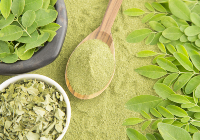
While Moringa is a superfood known to treat malnutrition in various cultures, it’s greatest impact is on respiratory health. A study has shown that the leaves and pods from the moringa tree (Moringa oleifera) inhibit 72% of all histamines released, making it almost as effective as the drug Ketoifen. It is also used in topical applications to treat inflammation of the skin such as in atopic dermatitis. But what is moringa and how can you make it a part of your healthy diet?
Found mostly in tropical regions of India and Africa, moringa contains proteins, vitamins, and minerals. It is also rich in plant compounds that work as antioxidants, which help protect our cells from damage. Other plant compounds found in Moringa have an action which may help ease the bronchial constriction and respiratory distress associated with asthma.
Since most of us aren’t going to find a moringa tree growing in the local forest, we have to acquire this superfood from a supplement, usually in powder, capsule, or tea form. These supplements can be derived from the leaves, stem, and seeds (also a food source in many countries). For general health, a cup or two of moringa tea is a delicious way to start or end the day. The tea has a mild sweet nutty flavor. A holistic health physician can help you determine the best form and dose of moringa to address specific health concerns.
